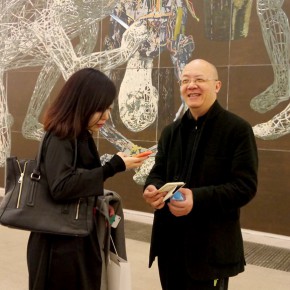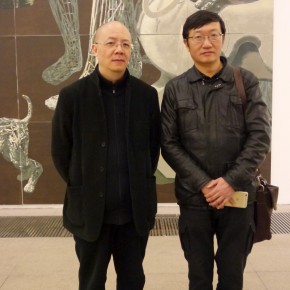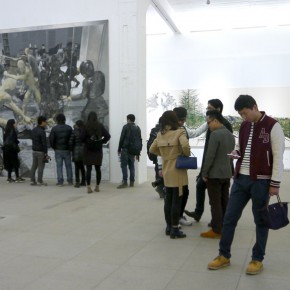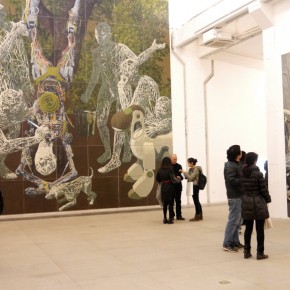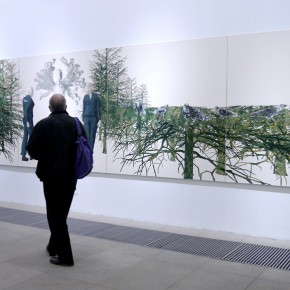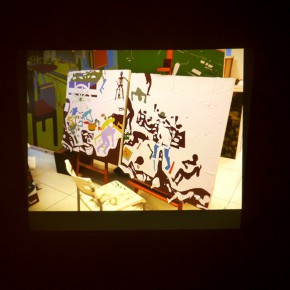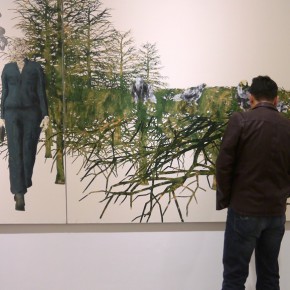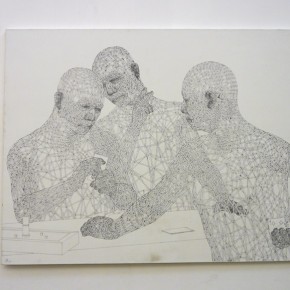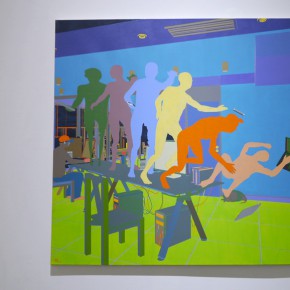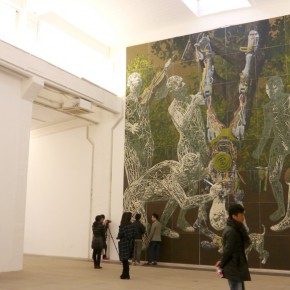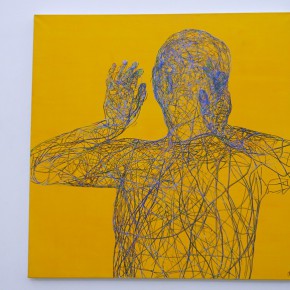
At 3:00 pm on March 12, “Save As” which is the second solo exhibition of Miao Xiaochun in 2015 opened at Beijing White Box Art Center. The exhibition is planned by Wang Chunchen, featuring 11 paintings created by the artist between 2011 and today.
Once entering the gallery, the audience will be shocked by the 800 x 800 cm giant painting “Public Enemy”. The viewer who is familiar with the history of classical art will easily see the shadows of classical oil paintings such as Rembrandt’s “Samson Was Blinded”, Caravaggio’s “The Cardsharps”, Bruegel’s“The Parable of the Blind Leading the Blind”, etc. from the exhibiting work. Miao Xiaochun cleverly combines his own language into these classical oil paintings, the disciples are replaced by the army of Che Guevara, the watchdog is replaced by a robotic dog, a cane of the blind is replaced by a computer... These wonderful transformations offer classical oil paintings contemporary interpretations. Miao Xiaochun said, “Ancient times is the present, the present is future. In fact, if looking back at the present from a distant time such as ten thousand years in the future, the distance between the classic and contemporary is short, the two dots located in the same time line are proximity.”
Miao Xiaochun was so addicted to the form of transformation using digital software and digital technology, that he developed it into painting. The curator Wang Chunchen defines it as “Algorithmic Paintings”. It is a result of a combination of the digital and manual work. He used a cutting plotter to carve the vector file created with 3D software, then transported it onto canvas to assist with manual painting. Evidently, such assistance plays an important role in the formation of the final painting style. It can be considered as a new form of painting, which is a significant revolution of painting with the development of digital technology. In this form, it does not only regard the liberation and breakthrough of painting's self-composition as a more important point, this form also combines with the human brain and computer calculation together, and achieves human-computer interaction and binding. Philosophically this success opens the era of man-machine cooperation. From the perspective of painting, it doubles the painting infinitely. From the perspective of vision, it makes visible our invisible world.
Since 2011, Miao Xiaochun has been thinking on how to use vector lines in his creation of paintings. Miao Xiaochun introduced the creative way of "Algorithmic Painting" during the interview that, at first, making the figures pose with 3D software, while using the deformation function of the software to convert them into crystal lattices and rendering their outlines into vector lines, which can be engraved on the lettering paper with a cutting plotter, and then it can be transferred onto the canvas through lettering paper, to remove every piece of lettering paper he draws on the canvas. Vector lines can be used to define the boundaries of figures, colors and the border between light and dark which can form different types and styles of painting. The artist is obsessed with tough figure edge lines. The structure and relationships between fronts and backs calculated by the computer is a new aesthetic feeling, meanwhile it is an experience. It is a new aesthetic feeling created by the combination of the subjective choice of the artist and the super computing of the computer.
Wang Chunchen says, "Algorithmic Painting" is from the same strain of Miao's artistic creation, and it has developed to some extent. An increasing number of artists now begin to use algorithm to create, which expands the function of algorithm vastly. For example, for abstract painting, after inputting multiple data, different kinds of abstract type can be conceived at random; or after inputting water ink elements and different drawing styles of writing, unexpected water ink composition will be created. International chess masters have been gaming with computers for years, and now, 3D print can be regarded as the application of the computer algorithm to the 3D production. So far, algorithmic painting is just a beginning, and Miao expands his art thoughts to form a chain of his art. It is predictable that he will continue to use the algorithm and 3D print to create the final works which can be called 3D printing sculpture.Certainly, the premise of all the man-machine integration is still the human brain. It is the autonomy of people that plays a decisive role. Like playing international chess with the computer, a computer's ability is always to fade next to people’s wisdom. Similarly, the premise of algorithmic painting is the artist's painting ideas and thoughts. It cannot draw automatically, but it can be an important part of the artist's painting language and tools.
Picasso had repeatedly decomposed and reconstructed the paintings by the masters such as Velazquez by using modern art such as color composition, usinga new language to create new paintings. Miao Xiaochun also uses computer calculations to create a new language. The artist will not promote such a language of man-machine integration, but he said, although Cubism did not actively promote its doctrine, it produced a very big effect, for example, Hockney’s photography which was diverted from Cubism, and it also imperceptibly influenced the fields of fashion, architecture, etc. At the same time he is also a teacher of the Photography and Digital Art Studio, CAFA. In the interview, he said he would never require or stopthe students, never offering suggestions on art, instead they freely choose their own directions, respecting their own feelings. MiaoXiaochun movingly said: “It is a fortunate thing that he is presented in the same exhibition with the artists who are much younger than he is.”
The creating cycle of Miao Xiaochun is about 4 years or 5 years, so he introduces the viewer to a large number of high-quality works in each exhibition. Shanghai Arario Gallery is showcasing the paintings of “color channels” style, which present gorgeous colors; the Beijing show mainly displays the paintings of “l(fā)attice deformation” style, which present more dignified colors and are bigger, followinga videoexhibition that isgoing to be launched in Nanjing.
This exhibition continues to April 20.
About the Exhibition
Curator: Wang Chunchen
Presented by: Sun Yongzeng
Exhibition Director: Liu Chenya, Cao Maochao
Exhibition Coordinator: Shen Feifei
Organized by: White Box Art Center
White Box Art Center March 12,2015-April 20,2015
Courtesy of the artist and White Box Art Center, translated by Chen Peihua and edited by Sue/CAFA ART INFO


